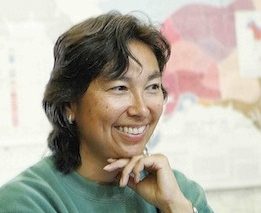In her effort to document the place names of her native King Island, Alaska, Deanna Paniataaq Kingston encountered cultural links to birds. Many of the names and stories referenced them. Kauna vaktuat is “the place where you can reach and get birds from rocks,” Tayaguq is “crested auklet place” and Iizrayaq is “sea gull cliff.”

King Island, a two-and-a-half-mile long garrison of rock jutting up out of the Bering Sea, is now uninhabited. But Native Americans lived there for centuries and created a rich culture that still survives among the King Island community on the mainland. Kingston is interviewing native elders from the community as part of a National Science Foundation-funded effort to document the cultural ecology, biogeography and the traditional ecological knowledge of the island.
“All I was looking for was just a list of names,” she told an audience May 2 at Oregon State University’s Center for the Humanities, “but whenever they talked about a particular name they told a story about it.”
An anthropologist, Kingston saw those stories as research questions.
“We’re going with the assumption that if they created folklore about it, that bird must have been important in some way to the people,“ she said. “Why it is important is the question I want to answer.”

To help her, Kingston brought in Kim Nelson, an ornithologist with the OSU Department of Fisheries and Wildlife. Nelson was excited because the King Island colonies of auklets, murres and kittiwakes had not been previously studied. “It’s a significant colony,” she said. “It has hundreds of thousands of birds. Nobody has done any research on the island.”
Most of the academic literature concerning the island’s wildlife has to do with the walrus and seals that the islanders hunted. But the stories that Kingston documented showed that the migrating seabirds living on the island from spring to fall also played a large part in the lives of the inhabitants.
Spring brings seabirds and a welcome respite from a diet of marine mammals. King Islands ate both the meat and the eggs of birds. So happy were the islanders to see the first arrival, the snowbird, that stories about them credit the birds with creating people.
Similarly, cormorants, the last birds to leave in the fall, also feature prominently in King Island stories.
Kingston and Nelson documented these stories along with the native bird names and colony place names and created a guide to the birds of King Island.
Kingston is conducting a similar effort on the island’s flora with OSU biologist Jesse Ford. She hopes to include fisheries and marine mammals if funding will allow.

For Nelson, the experience changed how she will work in the future. Nelson told the audience that involvement with local indigenous peoples will be part of her approach to new study sites from now on. “Ornithologists hunted for Marbled Murrelet nests for a hundred years,” she said. It wasn’t until after they were located in coastal old-growth forests that scientists found artwork by local Indians showing the birds nesting in trees, not the offshore cliffs where ornithologists had been looking.
“They knew,” she said, “but nobody bothered to ask them.”
Finally someone is bothering to ask.
On May 13, 2011, Kingston and Nelson gave a talk on their King Island research at the Traditional Ecological Knowledge in Ecosystem Sustainability Conference at OSU.
